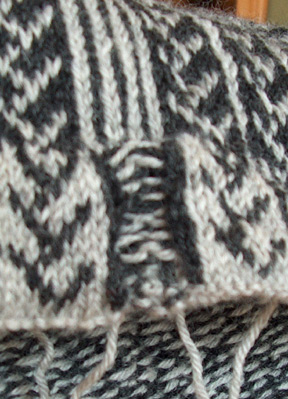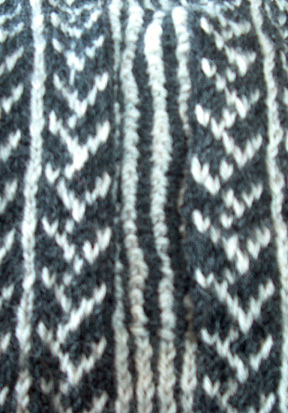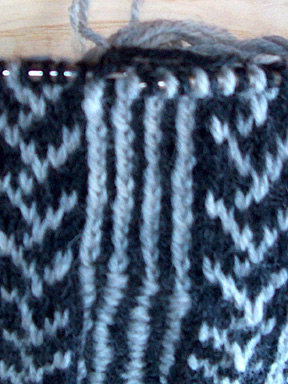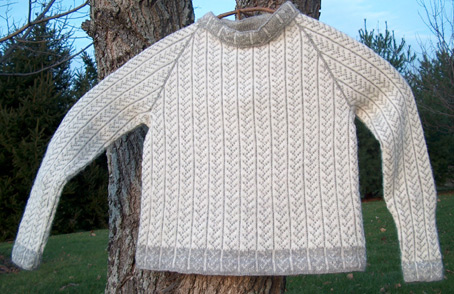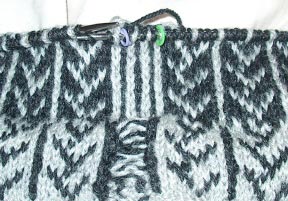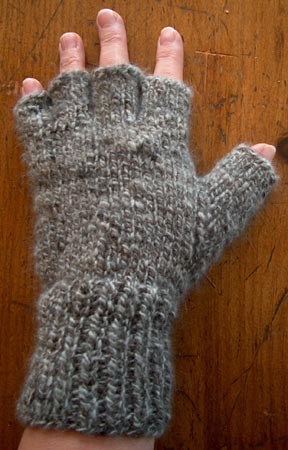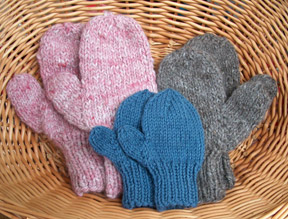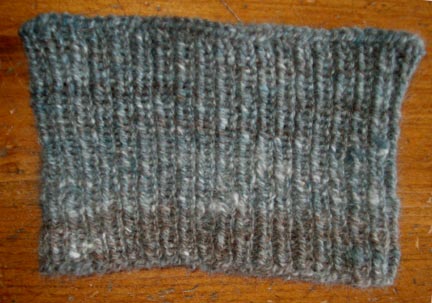January Sweater Knit A Long for Children In Common
Topic: percentage knitting
The Christmas Knitting got done and gifted so quickly and at the last minute, that picture taking did not happen. Now that the New Year is behind me, I am embroiled in my least favorite part of owning a yarn shop: inventory and bookkeeping. Trust me that January has become a very unfavorite month.
I do not allow myself to create anything new on my needles until the bookwork is all done. This is a discipline to keep me from diverting myself. However, I am bored with my life this way, so I continue to come up with something entertaining.
The CIC list is having a monthly Knit A Sweater For Bigger Kids in the orphanages of Russia. I am hosting a Percentage Knit-A-Long for a 36" sweater. It is great fun and I am very diverted by 30 minutes each morning as I answer the burning questions of the day from them. It's all good.
I have decided to include all the posts here to have an easy reference place should they have questions. Below is Week 1.
Jan 3, 2007:Good morning everyone!
In light of our new project for this new year, I had an idea. Actually, two ideas. One was to
create a sweater pattern that uses up odd colors and weights of yarn, and the next was to make
it a circular knit project so it would go faster.
Elizabeth made an excellent point about finished sweaters and vests not fitting over the victim's
head. Unfortunately, we do not get to see them when they are tried on. SO, I will add an offer
of my time to help anyone with any neck finish so
we can be sure the neck will be big enough. The easiest way to rectify this is to use a SEWN OFF
BIND OFF, which is worked with the end yarn and a darning needle. If anyone would like me to
post it right now, just holler. I am hoping to add it to the FILES section if it isn't there
already. In fact, it might be an idea to come up with a BEFORE YOU SEND YOUR BOX list of things
to check for?
At any rate, a circular knit sweater is a mystery to some knitters, but as soon as they do one,
the light bulb comes on. It's nice to know that when the knitting is done, there is only 20 more
minutes of finishing. I teach this technique all the time and it would be delightful to do so
here if anyone is interested. At the same time, it is wonderful to use up what you have AND make
an interesting sweater.
The age group we are knitting for this month will be varied, and I would tend to make all sweaters
for the teens in neutral colors. Those browns and grays and greens that gather dust in your closet
would be very wearable for a 14 year old boy. That is THE most requested item from the
teenagers who come into my shop...neutral color.
Most people have knitting worsted weight yarns in their stash (4 oz/100 gram and 190 - 220 yards
per skein). I would think that 800 yards of ONE color (4 skeins) knit together with 800 yards of
another or a combination of colors would create a great sweater. Working with two strands allows
for unique color combinations and quick knitting. I think #8 and #10 needles would work pretty
well with that final yarn weight. The idea is to aim for a 36" chest. The yarns weights and your
knitting gauge will determine the final outcome, so there are lots of ways to adjust the final
sweater AS IT IS BEING KNIT so it will turn out well proportioned for its size.
Another idea for color combinations...It takes a tad more than half the final yarn used to make
the body up to the underarms + 2 sleeves of a circular knit sweater. At that point, one can
change the base color OR the knit-along color and have the top/shoulders/neck slightly different.
Anyone up for this plan?
January 4, 2007
Cynthia, the neck info is posted below. Hope it is helpful. Your sweater amounts sound just fine.
Might I suggest something? Stripes are a PITA to weave yarn ends in, and there is a "jog" at each
color join with circular knitting that requires a fix that is sometimes not very good looking.
How about stranding your beige WITH your dark color and make a ragg yarn color? Very good looking
when knit, IMO. I am hoping that before everyone ships off their sweaters, we can get photos on
our site.
Carol, welcome aboard!!!
As Emm pointed out, Elizabeth Zimmermann was a trail blazer with her sweater percentage method,
and that is what I use to plot sweater numbers. The nice thing about starting with the sleeves,
is that it becomes the gauge swatch (!) and you plot the whole sweater based on how you are
knitting. Nice to do what you are already doing with the needles and yarn you have on hand, huh?
NECK BIND OFF THAT STRETCHES. When you make a knit bind off, or a knit/purl bind off in
pattern, even using a larger needle does not always guarantee that the edge will stretch,
although it makes the edge BIGGER. The secret to well fitting necks is:
1. the number of sts on the neck are sufficient to open to 20-24 inches (the size of most
preschooler-adult heads)
2. The edge sts have extra yarn built into them to allow for expansion.
the "bind off with larger needle" technique does work most of the time, BUT it does not relax
after being stretched. The necks on these sweaters, if really too small to begin with for
the sweater or the recipient, look bad after a few wearings.
First of all, to plot the numbers for the neck on ANY sweater you are making, and make sure they
equal 40-50% of the total number of sts AROUND the whole sweater. For instance, if a sweater has
50 sts on the front, and 50 on the back, that is 100 all together. 45% would be 40 sts, and 50%
would be 50 sts. So, somewhere between those two numbers is a safe zone, depending on the size of
the sweater.
Elizabeth Zimmermann found that babies and toddlers need 50% necks to get pullover sweaters
over their heads. Some adults like big necks, too, that don't bind or pull on their
ears/glasses when hey haul the sweater on. Adults who are using the sweater to keep warm
enjoy 40-45% necks, so that would make our example sweater neck need 40-45 sts.
A really great neck finish that is easy and fast is a neck roll. With a 16" circular needle,
pick up ALL the sts/spaces/holes (too many is better looking!) around the top of a sweater and
get ready to join the sts together as you start the 2nd round. Count what you have, plot what you
need, and decrease in the first round to the number you need. Knit around for 3-4" and bind
off with a sewn off bind off as follows:
SEWN OFF BIND OFF:
Cut yarn leaving 4x the measure around the stitches on the needle. Thread end through
darning needle. Cast off as follows: *Darning needle goes through 2 sts as if to purl.
Leave sts on needle. Darning needle goes through first st AGAIN, but as if to knit and then that
st is dropped off needle* Repeat * * until all sts have been cast off. Sew yarn to first st.
Happy Knitting!
January 5, 2007
Hi all. Looks like we have a crew onboard this project already! I am excited. I find
Knit-A-Longs to be a GREAT way to get something done and learn new stuff along the way.
Marie was so helpful to Cheryl Beth, and everything she said is right on. Our game plan for
this sweater will use samller needles for the ribbings and larger needles for the sweater.
I want to let everyone know right now that you can use WHATEVER SIZED needles you already own.
Do you have 7 and 9? How about 9 and 10 1/2? Pick two sizes apart that you have in your stash,
or can get easily.
Needle lengths:
1. You'll need double pointed and 16", 24" circular smaller needles
AND
2. 16" and 24" larger needles
Thst's the most common assortment you can use. THEN there is an alternative, which some of you
mentioned, and that is two circular needles of ANY length, in both sizes. These can do the
smaller cuffs and arms as well as the body and the neck.
Then there's a radical approach, but is the most economical if you are buying new needles (and we
all like to buy new needles!). Get 2 circular needles, in 40" or longer length, one small size
and one larger size. These can be used for MAGIC LOOP knitting, which I will be glad to explain
tomorrow, or perhaps someone here has the website address handy and can point folks there.
At any rate, with whatever needles and yarn (2 strands of worsted held together works well with
#8 and then #10 needles) you have, let's start the CUFFS as follows:
With your smaller double pointed needles, or your smaller circular needles, cast on 24 sts, JOIN
YOUR WORK, and work in *K1,P1* ribbing for 2". Place a marker, knit one, place another marker
(denotes the beginning of the round AND a center stitch). THEN, using your larger needles, and in
knit stitch only, INCREASE 6 sts evenly in the next round (which is 1 new stitch made after
every 4 sts knit), or *K4, inc* repeating around, ending K3, inc.
SLEEVES:
Knit for one inch. Make a new stitch on either side of the center stitch. *Knit for one more
inch. Make a new stitch on either side of the center stitch.* Repeat the directions from *to*
up the sleeve until you can measure 16" around the sleeve, and we'll talk more about that
tomorrow.
January 6, 2007
Hi Cheryl Beth and Marie
You guys are in danger of getting bogged down. Chill!!!!
One of the nicest things about "winging" a pattern is that it can give you tremendous leeway
when choosing your materials. So I am about to make a wild statement...use any needles you have
with any yarn you have and make a gauge swatch, such as you did Cheryl Beth, and just see what
the fabric looks like. Do you like it? Is it soft/firm enough? If you are not happy, change
the yarns or change the needle size until you get what you like to feel in your hands and can
imagine as a warm sweater on someone. We will, together, write the pattern numbers, based on a
nice gauge swatch. This will result in a sweater that will be wonderfully proportioned and work
well.
I am suggesting a 36" chest, but we/you can easily make bigger or smaller sweaters with this
method. So, if you feel you want to make a 40" chest, or a 32" chest, it's no big deal.
The cuff stitch number is based on a bulky yarn and big knitting gauge of 3 sts=1" with a 36"
finished chest measurement, which will fit someone with a 32" chest. Here is a chart of
children's sizes showing the sizes of parts of garments. Older kids sizes are there and we will
aim for the size 16 in our pattern. IF YOU WANT TO AIM FOR ANOTHER SIZE THAT IS FINE! Just ask
about tweaking your numbers and I'll be happy fill in any blanks:
http://www.yarnstandards.com/childsize.html
Way back in knitting history, knitters did not have the luxury of patterns and every needle size
imaginable to work with. Because they had to be creative and flexible, they managed to make
garments to fit without all the tools we have today. And they did. Which means you can, too.
Years ago I wrote a 44" sweater pattern for the Internet. It was for my (now 21 year old)
daughter. Bestsi's Raglan Sweater is posted on my website for all to use. You can read all the
way through the process to see how it goes:
https://countrywool.tripod.com/freepatterns/betsirag.htm
And do not be fearful about this method. Once you get all the way through it, you will better
understand circular sweater construction. You will start 2007 off with a new knitting skill and
the orphans will have another sweater!
January 7, 2007
Hi all
Welcome to the newest Knit-Along members!
Jessica asks if this is knit in the round. YES, indeed! This pretty much eliminates finishing,
so the sweater gets done sooner.
Kelly wants to know the advantage of bottom up or top down construction. It's good either way.
I generally make my designs bottom up, as it is easier to figure the percentages. I also find
that decreases look better than increases, which makes the shoulder area construction tidier to
look at. Finally, cast off edges can be a problem for a newer knitter. Casting off the hem edge
at the bottom for a top-down knit never looks right the first time you do it and tends to flair.
It is much easier (and faster) to work a sewn-off bind off around the neck of a bottom-up knit
sweater for a professional looking edge.
And Sharon, I think that apricot and brown knit together would make a WONDERFUL marled yarn
ragg-look sweater! I believe 800 yards of each color in a worsted-type weight yarn should be
enough if knit together.
SLEEVES:
When last we left the sweater construction, we were making sleeves in the round. The intent was
to add increases every inch, two at a time, until the sleeve measured 16" around or 8" across.
Measuring this while on the needle can be daunting, so here is a tip:
Take the time to carefully measure the gauge you are knitting at once you get 6 inches past the
cuff. Take a flat ruler and lay it against the knitting 2" below the needle. Find the "0" and "4"
on your ruler and place a straight pin IN the knitting at those two points. Take the ruler away,
find excellent light and take some time to count the stitches between the pins. Each stitch
consists of 2 slanted sides that meet either at the top OR the bottom, depending on which slant
you start counting with. Make sure you count any half or quarter stitches you are looking at on
the edge of your carefully marked 4". A half stitch would be a full slant without an opposite
partner, and a quarter stitch would be half a slant. Take this number of sts and divide it by 4.
If you have 13.25 sts in your 4", then your gauge is 13.25/4=3.3 sts. Yes, it looks messy at
this point, but it is only math and makes the final sweater measurement accurate.
So find your gauge on the sleeves and multiply it by the 16" you need..3.3 x 16 = 52.8 sts.
At this point you can round it to 52 or 54, whatever makes you happier.
So, you need to keep increasing on the sleeve in our example sweater with a 3.3 sts=1" gauge
until you have 52(54) sts.
Is anyone having trouble with this? I will be happy to help.
Posted by countrywool
at 7:31 AM EST

